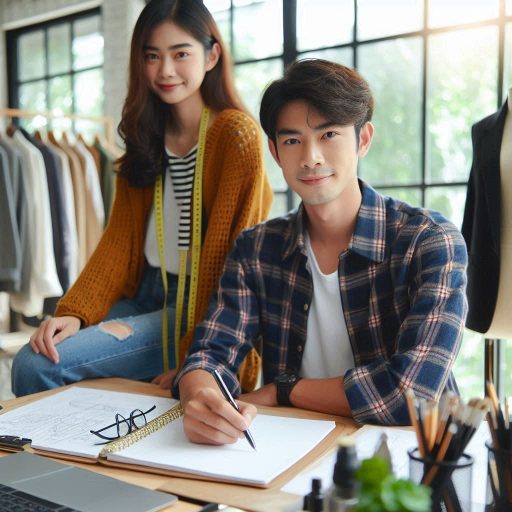Introduction
Fashion design collections are crucial for establishing a designer‘s identity and vision.
They serve as a cohesive representation of a designer‘s style and creativity.
Collections showcase a designer‘s ability to create a harmonious blend of garments that tell a story.
Each collection is a reflection of current trends, personal inspiration, and the designer’s unique perspective.
Developing a fashion design collection involves several key steps, each contributing to the final presentation.
First, designers identify their core concept or theme.
This theme guides every design decision and ensures a unified look throughout the collection.
It could be inspired by art, culture, or personal experiences.
Next, designers conduct extensive research.
They analyze current fashion trends, fabric innovations, and emerging color palettes.
This research helps designers stay relevant and anticipate future trends.
It also informs their fabric choices and design techniques.
Once research is complete, designers sketch initial designs.
These sketches act as a visual guide for the collection.
Designers experiment with different silhouettes, patterns, and details.
They refine these sketches into detailed technical drawings.
Research and Inspiration
Explore Current Trends in the Fashion Industry
Developing a compelling fashion design collection begins with thorough research.
Start by exploring current trends in the fashion industry to ensure your designs resonate with today’s market.
Look at recent runway shows to identify dominant styles, colors, and fabric choices.
Fashion magazines and online platforms are excellent resources for understanding what‘s trending.
Pay attention to seasonal collections and notable designers.
Analyze emerging trends to predict future directions.
This knowledge helps you stay relevant and innovative, allowing your collection to appeal to contemporary tastes while also pushing boundaries.
Gather Inspiration from Various Sources Such as Nature, Art, and Culture
Inspiration is crucial in the creative process.
Gather ideas from a wide range of sources to infuse your collection with unique and fresh elements.
Nature, with its rich textures, colors, and patterns, offers an endless source of inspiration.
Observe how natural landscapes, flora, and fauna can influence your design choices.
For example, the intricate patterns of a butterfly‘s wings or the color palette of a sunset can spark innovative design ideas.
Art also provides a vast reservoir of inspiration.
Explore various art forms, from classical paintings to modern installations.
Art movements, such as Impressionism or Surrealism, can inspire your designs with their distinctive aesthetics and emotional depth.
Visit art galleries and museums to immerse yourself in different artistic expressions.
Analyze how art and fashion intersect, and use these insights to enhance your creative vision.
Culture is another rich source of inspiration.
Traditional clothing, historical garments, and cultural artifacts offer a treasure trove of design elements.
Dive into the history and significance of various cultures to understand their influences on fashion.
For instance, the patterns and colors of traditional Japanese kimonos or the intricate beadwork of Native American garments can provide unique motifs and design ideas for your collection.
Create Mood Boards to Visually Convey Ideas and Themes
Once you have gathered inspiration, create mood boards to visually organize and convey your ideas.
Mood boards are essential tools in the design process, helping to translate abstract concepts into a tangible visual format.
Collect a variety of materials, including images, fabric swatches, color samples, and sketches.
Arrange these elements on your board to represent your design vision cohesively.
A well-constructed mood board acts as a visual guide throughout the design process.
It helps you identify key themes, colors, and textures that will define your collection.
Use it to experiment with different combinations and see how they work together.
Ensure that the elements you choose align with your overall concept and enhance your design narrative.
As you develop your mood board, consider how each piece contributes to the overall theme of your collection.
Focus on creating a harmonious balance between colors, textures, and silhouettes.
This visual organization will help you maintain consistency and coherence in your designs.
By combining trend analysis, diverse sources of inspiration, and effective visual organization through mood boards.
You can craft a fashion collection that is both innovative and cohesive.
This structured approach not only ensures that your designs are aesthetically pleasing but also relevant and impactful within the fashion industry.
Read: Freelance vs. In-House Costume Design Jobs
Concept Development
Define the Vision and Story Behind the Collection
The first step in developing a fashion design collection is defining your vision and story. Your vision should reflect the essence of your collection.
Think about what message you want to convey and how you want your audience to feel.
This story will guide all your design decisions and shape your collection‘s identity.
Develop a Color Palette and Fabric Selection That Aligns with the Concept
Next, choose a color palette that complements your vision.
Colors evoke emotions and set the tone for your collection.
Select hues that resonate with your story and ensure they work well together.
A well-chosen palette can unify your designs and create a cohesive look.
Fabric selection is equally important.
Fabrics bring texture and dimension to your designs.
Pick materials that align with your concept and enhance your color choices.
Consider how each fabric will drape and move to achieve the desired effect.
Your fabric choices should support the functionality and aesthetic of your collection.
Create Sketches and Design Drafts to Bring the Concept to Life
Once you have your concept, color palette, and fabrics, start creating sketches and design drafts.
Sketches are the first tangible expression of your ideas.
They help you visualize how your concept translates into garments.
Begin with rough sketches to explore different shapes and silhouettes.
Refine your sketches to detail the design elements.
Design drafts should include more precise details.
Develop each design to include aspects like stitching, embellishments, and closures.
Ensure your drafts are aligned with your vision and story.
These drafts will serve as the blueprint for your final collection.
Throughout this process, stay focused on your initial concept.
Every design decision should reinforce the story you want to tell.
Be prepared to adjust and refine your designs as you progress.
Flexibility will help you overcome challenges and enhance your collection‘s overall coherence.
Defining your vision, selecting a color palette and fabrics, and creating detailed sketches are crucial steps in developing a fashion design collection.
Each element should align with your story and enhance your designs.
Through careful planning and execution, you‘ll bring your fashion collection to life.
Material Sourcing
Material sourcing is a crucial step in developing a fashion design collection.
Start by researching fabrics that match your collection‘s theme.
Each material should enhance your design concept and complement your vision.
Dive into fabric catalogs, visit textile fairs, and consult with industry experts.
Explore various fabric types to find those that best fit your design needs.
Consider Ethical and Sustainable Options for Fabric Sourcing
Consider ethical and sustainable options when choosing fabrics.
Eco-friendly materials and practices have become vital in fashion.
Look for suppliers who prioritize sustainability and ethical practices.
Organic cotton, recycled polyester, and other green alternatives are worth exploring.
Sustainable fabrics not only support the environment but also appeal to eco-conscious consumers.
Build Relationships with Suppliers to Ensure Quality and Consistency
Build strong relationships with your fabric suppliers.
Reliable suppliers ensure consistent quality and timely delivery.
Maintain open communication to discuss your specific needs and expectations.
Regularly update them on your collection‘s progress and requirements.
Establishing a good rapport helps in negotiating better terms and securing high-quality materials.
When selecting materials, prioritize quality and durability.
High-quality fabrics enhance the overall appearance and longevity of your collection.
Test fabric samples for texture, colorfastness, and wear resistance.
Ensure that your materials align with the design‘s functional and aesthetic requirements.
Evaluate the cost of materials and manage your budget effectively.
Balance between premium fabrics and cost-efficiency without compromising on quality.
Keep track of your expenses and adjust your sourcing strategy as needed.
A well-managed budget helps in maintaining financial stability throughout the design process.
Always stay updated on the latest fabric trends and innovations.
Emerging technologies in textile production can offer new possibilities for your collection.
Explore new fabric types and techniques to keep your designs fresh and relevant.
Building a network of reliable fabric suppliers and staying informed about sustainable options will enhance your design collection.
Effective material sourcing lays the foundation for a successful and impactful fashion collection.
Read: Networking Events for Costume Designers
Design and Prototyping
Developing a fashion design collection involves various stages, including designing and prototyping.
This process is crucial in bringing your creative vision to life and ensuring that your collection is cohesive and well-executed.
In this section, we will discuss the importance of design and prototyping in the fashion design process.
Creating Initial Samples and Prototypes
Creating initial samples and prototypes is the first step in bringing your design ideas to reality.
These samples serve as the foundation for your collection and allow you to see how your designs translate from sketches to actual garments.
It’s essential to experiment with different fabrics, colors, and silhouettes during this stage to test out different possibilities and refine your vision.
Making Adjustments to Patterns and Silhouettes
Once you have created your initial samples, it’s crucial to evaluate them and make necessary adjustments to the patterns and silhouettes.
Pay close attention to how the garments fit on the body, how the fabrics drape, and how the overall aesthetic aligns with your design concept.
Use feedback from trusted sources, such as fellow designers or industry professionals, to refine your designs and ensure that they are both visually appealing and functional.
Collaborating with Skilled Artisans and Technicians
Collaborating with skilled artisans and technicians is essential in perfecting your garments and bringing your designs to life.
Whether you work with patternmakers, sewers, or textile experts, having a team of experienced professionals can help you achieve the level of craftsmanship and quality that you desire for your collection.
Communicate clearly with your collaborators, provide detailed instructions, and be open to their suggestions and expertise to create garments that stand out in terms of design and construction.
Therefore, the design and prototyping stage of developing a fashion design collection is a crucial part of the creative process.
By creating initial samples and prototypes, making necessary adjustments, and collaborating with skilled artisans and technicians.
You can ensure that your collection is well-executed and reflects your unique design vision.
Remember to stay open to feedback, be willing to make changes, and strive for excellence in every aspect of your collection.
Read: Building a Portfolio for Costume Design

Production Planning
Production planning transforms your fashion design collection from concept to reality.
To succeed, follow these essential steps.
Determine the Quantity of Each Design
Start by deciding how many pieces of each design you will produce.
Consider your target market and sales projections.
Analyzing past trends helps gauge demand.
Balance between overproduction and underproduction.
Too many items may lead to excess inventory, while too few can result in missed sales.
Ensure you are realistic about what you can sell and what the market needs.
Create a Production Timeline
A detailed production timeline is crucial for meeting deadlines.
Outline each stage of production from design finalization to delivery.
Include time for sample creation, revisions, and approval processes.
Factor in potential delays and set buffer periods to address unforeseen issues.
Coordinate with your team and manufacturers to align timelines.
Regularly update the timeline to reflect any changes or adjustments.
This keeps everyone on track and ensures timely completion of your collection.
Transform Your Career Today
Unlock a personalized career strategy that drives real results. Get tailored advice and a roadmap designed just for you.
Start NowSource Manufacturers and Establish Partnerships
Finding reliable manufacturers is a key component of production planning.
Research potential partners who align with your quality standards and production needs.
Evaluate their capabilities, turnaround times, and cost structures.
Establish clear communication channels to ensure smooth interactions.
Negotiate terms and conditions that benefit both parties.
Draft agreements that outline expectations, payment terms, and delivery schedules.
Build strong relationships with your manufacturers to foster trust and reliability.
This partnership is crucial for producing high-quality garments on time.
Manage Quality Control
Implement quality control measures throughout the production process.
Regularly inspect samples and finished products to ensure they meet your standards.
Address any issues promptly to avoid costly mistakes.
Establish quality checkpoints at various stages of production.
Communicate any quality concerns to your manufacturer immediately.
This proactive approach helps maintain consistency and high standards in your collection.
Plan for Logistics and Distribution
Effective logistics planning is vital for timely delivery to your customers.
Arrange for warehousing and inventory management.
Plan your distribution strategy, including shipping methods and partners.
Ensure that your supply chain is efficient and cost-effective.
Coordinate with retailers or direct sales platforms to align delivery schedules.
Proper logistics planning prevents delays and ensures your collection reaches the market as planned.
Production planning is a detailed process involving quantity determination, timeline creation, manufacturer sourcing, quality control, and logistics.
By carefully managing each aspect, you ensure that your fashion design collection is produced efficiently and successfully launched to the market.
Read: Famous Costume Designers in Hollywood
Uncover the Details: Educational Pathways for Aspiring Landscape Architects
Marketing and Promotion
Develop a Marketing Strategy to Promote the Collection
To launch a successful fashion collection, you must develop a comprehensive marketing strategy.
Start by identifying your target audience.
Determine who will appreciate and buy your designs.
Once you know your audience, craft messages that resonate with them.
Your strategy should include clear goals and measurable objectives.
Allocate resources effectively to achieve these goals and track your progress.
Collaborate with Photographers, Models, and Stylists for Photoshoots
Next, collaborate with photographers, models, and stylists to create compelling visuals.
Hire a skilled photographer to capture your designs in high-quality images.
Choose models who embody your collection‘s aesthetic and can bring your vision to life.
Work with stylists to ensure each look is showcased perfectly.
Organize photoshoots that reflect the essence of your collection, paying attention to the setting, lighting, and mood.
These professional images will be crucial for your promotional efforts.
Utilize Social Media and Other Platforms to Showcase the Collection to a Wider Audience
Leverage social media to reach a broader audience.
Create engaging content that highlights your designs, including behind-the-scenes footage, fashion tips, and styling ideas.
Use platforms like Instagram, Facebook, and Pinterest to engage with potential customers and build a following.
Invest in social media advertising to boost your visibility.
Target ads to your specific audience for maximum impact.
Monitor the performance of your campaigns and adjust strategies as needed.
Don‘t ignore traditional media channels.
Reach out to fashion magazines, blogs, and online publications for features or reviews.
Hosting a launch event or fashion show can also generate buzz.
Invite fashion industry professionals, influencers, and media representatives to create a memorable impact.
Engage with fashion communities and forums online.
Share your journey and updates about your collection.
Participate in discussions to build relationships within the industry.
Use email marketing to keep your audience informed with newsletters featuring updates, exclusive previews, and special offers.
Track your marketing efforts and assess their effectiveness.
Analyze engagement metrics, sales data, and audience feedback.
Use this information to refine your strategy and improve future promotions.
By developing a strategic marketing plan, collaborating with key creatives, and leveraging various platforms.
You can effectively showcase your fashion design collection and make a significant impact in the industry.
Presentation and Launch
Organize a Fashion Show or Presentation to Debut the Collection
Launching a fashion design collection requires a strategic presentation to capture attention and showcase creativity.
Begin by organizing a fashion show or presentation.
Choose a venue that complements your collection‘s theme and style.
Ensure the location offers ample space for your designs to shine.
Plan every detail meticulously.
Coordinate with stylists, models, and makeup artists to align with your vision.
Prepare a detailed run-of-show to keep everything on track.
Timing and precision are crucial for a smooth presentation.
Invite Press, Buyers, and Influencers to Showcase the Designs
Extend invitations to key industry figures to attend your event.
Reach out to press, buyers, and influencers who can amplify your collection‘s reach.
Craft personalized invitations to make them feel valued and intrigued.
The presence of influential guests can significantly boost the collection‘s visibility and credibility.
During the show, focus on creating a memorable experience.
Ensure the lighting and music enhance your designs.
The atmosphere should reflect your collection‘s mood and message, engaging the audience with a well-curated presentation that highlights each piece.
Collect Feedback and Analyze the Response to Determine the Collection’s Success
After the show, collect feedback from attendees, including press, buyers, and influencers.
Analyze their responses to gauge how well the collection resonates with the target market.
Pay attention to both positive feedback and constructive criticism.
Evaluate the media coverage your collection receives, assessing the impact of press reviews and social media mentions.
The amount of buzz generated can indicate the collection‘s success.
Monitor sales and interest from buyers, as successful collections typically show strong post-show sales and positive retailer engagement.
Compare initial reactions to actual performance to refine future strategies.
In summary, the presentation and launch phase is critical.
It is your opportunity to make a lasting impression and set the stage for your collection‘s success.
By organizing a well-executed show, inviting the right guests, and analyzing feedback, you can effectively gauge the impact of your designs and plan for future improvements.
Conclusion
In the world of fashion, creativity fuels innovation and drives trends.
To develop a successful fashion design collection, creativity is indispensable.
It pushes boundaries and introduces fresh perspectives.
Passion for design ignites this creative spark, making every detail of your collection unique.
Without it, even the most technical skills fall short.
Dedication is equally crucial.
Crafting a collection involves long hours, meticulous planning, and relentless effort.
Designers must navigate countless challenges and setbacks.
Each garment should reflect a deep commitment to quality and originality.
This dedication will set your collection apart and attract attention in a crowded market.
Collaboration can enhance creativity and improve your collection.
Working with skilled professionals, such as pattern makers and fabric suppliers, can bring your vision to life.
Their expertise can provide valuable insights and elevate your designs.
Building strong relationships within the fashion industry opens doors to new opportunities and resources.
Aspiring designers should embrace their passion and let it guide their work.
Your unique vision and style are your greatest assets.
Trust your instincts and be bold in your approach.
Creating a collection that reflects your personal perspective will resonate more with your audience.
[E-Books for Sale]
The Big Book of 500 High-Paying Jobs in America: Unlock Your Earning Potential
$19.99 • 500 High-Paying Jobs • 330 pages
Explore 500 high-paying jobs in America and learn how to boost your career, earn more, and achieve success!
See All 500 High-Paying Jobs of this E-Book
1001 Professions Without a Degree: High-Paying American Jobs You Can Start Now
$19.99 • 1001 Professions Without a Degree • 174 pages
Discover 1001 high-paying jobs without a degree! Unlock career tips, skills, and success strategies for just $19.99!




